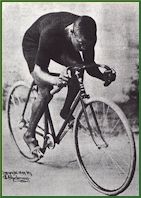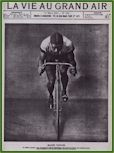 |
|
Champion cyclist beat Jim Crow TELEGRAM & GAZETTE
The New York race promoters who signed 19-year-old Marshall W. "Major" Taylor to their team in 1898 knew that fans would flock to see "the Worcester Whirlwind" compete. They also knew that controversy surrounding "the Colored Cyclone," whose star was rising in muscular defiance of the Jim Crow segregation permeating the sport, was sure to generate headlines. And any kind of publicity would be good for the box office. Today, Taylor's name is still an attraction. When the Seven Hills Wheelmen bicycle club of Worcester renamed its annual 100-mile ride the Major Taylor Century in honor of the 1899 world champion who lived here, the ride's appeal was suddenly extended. "We came just because of the name," said Eloy Toppin of Hartford, who biked the century in September with several friends from the Octagon Cycling Club, all wearing custom-made cycling jerseys with Major Taylor's picture emblazoned on the front. "We wanted to be a part of it." Toppin, 41, and three other African-American biyclists formed the Hartford-area riding group two years ago as the See-Saw Cycling Club, using the name of Taylor's first racing team. The original See-Saw club was a black team formed in 1895 in response to the exclusively white Zig-Zag Cycling Club in Taylor's boyhood hometown, Indianapolis. The modern-day Hartford group, which is not a racing
club and is now integrated, later came up with a new name "because
we didn't want to step on history," Toppin said. "The
feeling was that See-Saw should remain what it was."
"I was in Worcester only a very short time before I realized that there was no such race prejudice existing among the bicycle riders there as I had experienced in Indianapolis," Taylor wrote in his 1929 autobiography, "The Fastest Bicycle Rider in the World." Worcester's hilly terrain provided challenging training ground. Taylor became known for biking up steep George Street, a 23 percent grade that runs about 100 yards from Main Street up to Harvard Street near the courthouse. Race relations remained a challenge as well. In 1897 Taylor had to abandon the quest for national sprint points champion when Southern race promoters refused him entry to key competitions. When he did compete, hostility from white riders included conspiratorial race tactics, threats and physical assault. One time in Taunton, a competitor pulled Taylor from his bike and choked him into unconsciousness. The offender was slapped on the wrist with a $50 fine, but Taylor didn't lose his nerve -- or his popularity. In 1900, when Taylor bought a house on Hobson Avenue in Worcester's Columbus Park neighborhood, near Coes Pond, white neighbors were upset and offered to buy back the house for $2,000 more than he had paid. Taylor refused. In the end, the neighborhood grew to accept its distinguished black resident, whose racing career made him one of the wealthiest blacks in the country. Taylor embraced religion after his mother's death in 1898 and was a steadfast member of the John Street Baptist Church in Worcester. For years, he resisted invitations to race in Europe because he refused to race on Sundays. He finally signed a European contract in 1901, was welcomed as a hero in France, and proceeded to beat every European champion.
Although the European press always made references to Taylor's skin color, the labels were largely to give him a strong, recognizable identity, not to judge him or comment on his social standing. "For the first time in his life, it was an advantage for him to be black," Ritchie wrote. Major Taylor | Statue | Events | Donations | News | Friends | Home Major Taylor Association, Inc. P.O. Box 20131 Worcester, MA 01602 info@majortaylorassociation.org ©2000 - 2002 Major Taylor Association, Inc. All rights reserved. Web design by Tom Swenson. |


